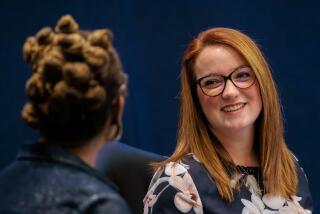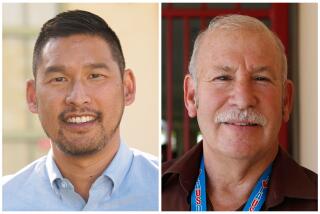New Trustee’s Election to Simi Board Jeopardizes Middle School Plan
- Share via
The Simi Valley Unified School District, which has been preparing to switch from three-year to four-year high schools next fall, may have to scrap its plans as a result of last week’s elections.
Debbie Sandland, an outspoken critic of the so-called middle school program, collected more than 20,000 votes to capture a seat on the school board. And Sandland said her top priority will be to reverse the board’s decision to implement its reconfiguration plan next September.
“I feel I have a mandate from the community,” she said.
The Simi Valley school district is now the only district in the county without a middle school program. Under this system, elementary schools are rearranged to include kindergarten through 5th grades, middle schools 6th through 8th, and high schools 9th through 12th.
In Simi Valley’s current system, elementary schools include kindergarten through sixth grades, junior high schools 7th through 9th, and high schools 10th through 12th.
Sandland, who would provide the swing vote on reconfiguration, said she opposes the middle school program because it will cost an estimated $600,000 to start and at least another $250,000 a year in ongoing expenses.
“Until all education programs are adequately funded, I don’t think we should implement reconfiguration,” Sandland said. “We have too many other needs.”
Sandland noted that the district has already implemented many of the middle school teaching methods at the junior high level.
“I see no reason to restructure our schools to implement some of these ideas,” she said. “We can do it in the present structure and not spend a lot of money.”
Mary Ann Overton, a middle school consultant with the state Department of Education, said that for several years, there has been a nationwide trend toward the middle school system because it groups students together to more closely match their physical, emotional and intellectual development.
Overton said there are also academic advantages. For example, she said, in middle schools, subjects such as math and science are taught by a small group of teachers who organize their classes to show students how the different subjects interrelate. And ninth-graders entering high school are offered more counseling services and advanced classes to better prepare them for college.
After several years of studying and weighing the benefits and costs of the middle school system, the Simi Valley school board voted 3 to 2 last year to reconfigure its schools beginning in the fall of 1993.
School board members Doug Crosse, Judy Barry and Kenneth Ashton, who retired from the board this year, provided the majority vote.
Barry, who was reelected to the board last week, said she will continue to support moving ahead with reconfiguration because the district has already invested time and money in preparing for the change.
She said the district can afford to switch to a middle school program, noting that it has $9.8 million in its general fund account. However, $4 million of that is already earmarked for expenses this year and another $3 million is considered the district’s emergency reserve.
Barry said she is not going to give up the fight for middle schools.
“I’m not going to lay down like a lamb,” she said. “This is not a finished issue. I have studied middle schools, I have researched them. I am convinced this is best for our kids.”
Barry said she feels that Sandland does not have a mandate to reverse the previous board’s decision. She pointed out that she herself collected more than 19,000 votes in the election.
But Simi Valley school board members Carla Kurachi and Diane Collins, who also won reelection last week, said that while they like the middle school concept, they still have concerns about costs and space problems at the district’s two high schools.
If reconfiguration were to occur, Simi Valley High would have to absorb 800 additional students and Royal High an additional 650 students. Simi Valley High now has about 2,000 students and Royal High about 1,700.
“I do feel middle schools are a good way of going if you have the proper space and proper finances,” Kurachi said. “I just don’t see that we have either one.”
School officials said that the $600,000 start-up cost would pay for portable classrooms, moving equipment and the hiring of two new assistant principals and two new counselors for the high schools. The $250,000 yearly ongoing costs of the switch include the new employees’ salaries and benefits.
Collins said reconfiguration is “a money issue” and Sandland’s election was proof that the community has the same concerns about how it would financially affect the district.
“Obviously, this was a vote by the community that people don’t really want it,” she said.
Peggie Noisette, a French teacher at Valley View Junior High and president of the Simi Valley Educators Assn., said some “team teaching” is already being done at the district’s four junior high schools.
“It would be ideal” to switch to a complete middle school program, Noisette said. “But if we don’t make the change, the kids will still get a good education.”
Noisette said the majority of the district’s 800 teachers support reconfiguration but also have concerns about costs and overcrowding in the classroom. She said the union also wants to be sure that sixth-grade teachers are given a prep period to plan their classes.
“Educationally, middle schools are the way to go,” she said. “The reservations that the teachers have is that it has to be done right.”
More to Read
Sign up for Essential California
The most important California stories and recommendations in your inbox every morning.
You may occasionally receive promotional content from the Los Angeles Times.










